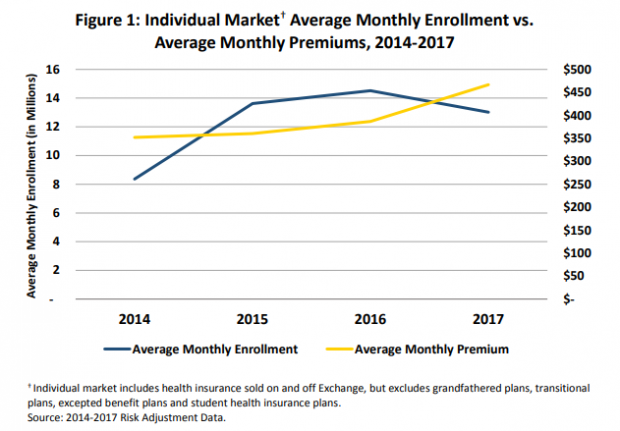President Trump has declared that Obamacare is finished, dead, gone, essentially repealed. And yet, despite the administration’s efforts to undermine the law’s marketplaces, the number of Americans who enrolled in and started paying for Affordable Care Act plans grew slightly this year, according to reports released Monday by the Centers for Medicare and Medicaid Services (CMS).
At the same time, rising premiums are taking a toll, forcing many middle-income Americans — individuals making more than about $48,000 a year, or families of four making more than about $100,000 — to drop coverage. “Taken together, these reports show that state markets are increasingly failing to cover people who do not qualify for federal subsidies even as the Exchanges remain relatively stable,” CMS said.
Here’s a look at what the new reports show:
* While the total number of people who picked a plan for 2018 fell, the number of people who paid for coverage rose from 10.3 million in February 2017 to 10.6 million this past February, an increase of about 3 percent. “The increase is striking because it happened even though federal health officials last year slashed ACA funding to grass-roots groups that help consumers sign up for coverage, cut advertising and other outreach activities by 90 percent, and shortened the enrollment period by half,” writes Amy Goldstein at The Washington Post.
* CMS argued that, based on historical trends, a “significant number” of people will wind up dropping coverage during the year even after making their initial payments. Of the 10.3 million who paid for their plans as of March 15, 2017, only 8.9 million were still in those plans by the end of the year. “This is likely caused by consumers struggling to pay premiums as costs continue to increase,” the CMS report said.
* A larger share of enrollees has been getting federal subsidies. In 2014, the first year Affordable Care Act plans became available, 55 percent of those enrolled in individual market plans on or off the new Obamacare exchanges got financial help, according to Bloomberg. Last year, 62 percent did. In all, more than 8 million people got subsidies last year, while 5 million bought individual plans without financial help. “When premiums rise a lot, a lot more people become eligible for subsidies,” Matthew Fiedler, a fellow at the U.S.C.-Brookings Schaeffer Initiative for Health Policy, told The New York Times.
* As insurance prices rose by an average of 21 percent last year, signups among people who did not qualify for subsidies fell by 1.3 million — a drop of 20 percent compared with 2016. Subsidized enrollees fell by just 3 percent. “These reports show that the high-price plans on the individual market are unaffordable and forcing unsubsidized middle-class consumers to drop coverage,” CMS Administrator Seema Verma said in a statement. Trump administration policies may have played a part in the decline, too, and some people may have stopped buying their own insurance because they found jobs with employer coverage. “But it’s reasonable to think that most of the attrition can be attributed to the spike in prices, as the Trump administration concludes,” writes Margot Sanger-Katz of The New York Times.
What it all means: “The individual health insurance market under the ACA is financially sustainable as subsidies rise to match premium increases,” Larry Levitt of the Kaiser Family Foundation tweeted. “However, the lack of affordable insurance for middle-class people ineligible for subsidies does not seem politically sustainable.”







